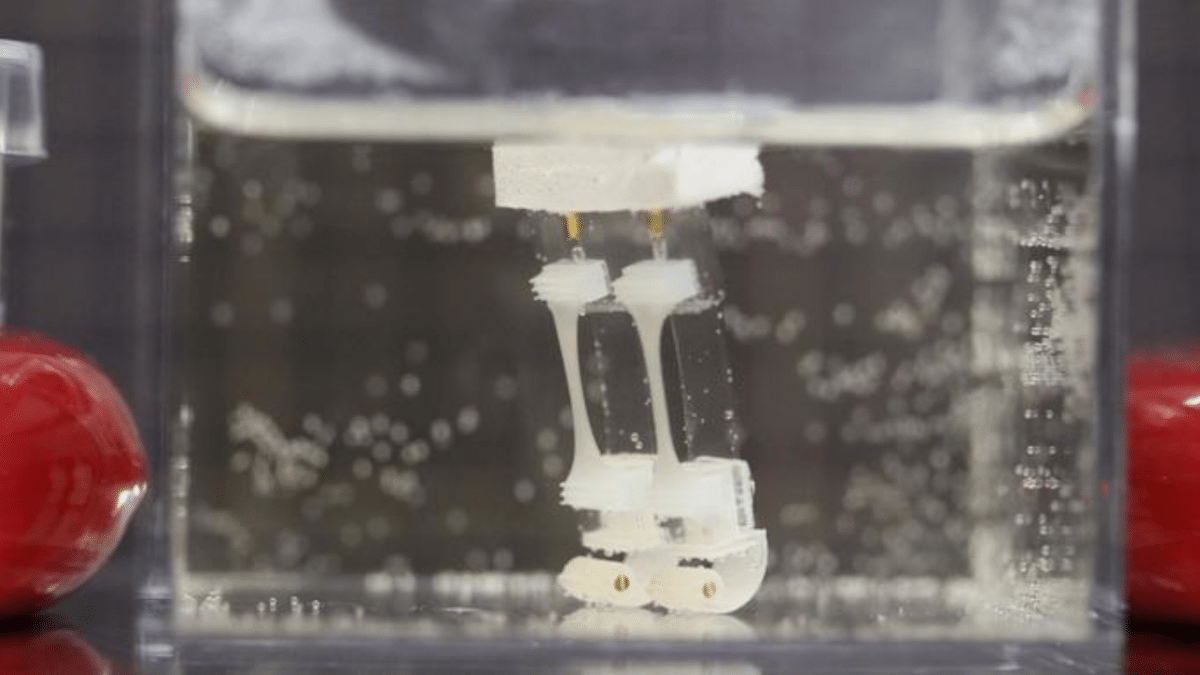Robot legs move with muscle power
Research into “biohybrid robots” that combine biological and mechanical components is developing dynamically because biological materials are comparatively light and flexible, convert energy into movement quite efficiently and can also regenerate themselves. At least that is the great hope. A running machine with cultured muscle cells that Japanese researchers have now presented at least shows the potential of this technology.
Advertisement
Shoji Takeuchi and his colleagues at the University of Tokyo grew muscle cells from rats in the laboratory, and then deposited these cells in several layers on a flexible substrate, where they networked with each other. In this way, flat bands of muscle tissue were created, which they attached to a plastic skeletal construct from the 3D printer. Driven by electrical pulses, the little biped moves forward at around five millimeters per minute. The researchers describe technical details in an article in the journal “Matter”.
Living machines
The Japanese researchers are not the first to create hybrid, half-living, half-machine creatures. There have been some spectacular successes in this area recently. In 2016, for example, a team at Harvard University constructed a type of mini-ray powered by rat heart muscle cells embedded in an elastomer. The cells were genetically modified so that they could be triggered by light pulses and then contract.
In 2022, this team presented an autonomous robot fish powered by human heart cells. Unlike previous projects, this hybrid robot did not need to be powered externally by electricity or light. The biohybrid mechanism, modeled on zebrafish, contained two layers of muscle cells, one on each side of the caudal fin. As one side contracted, the other expanded, which caused channels in the cell’s membranes to open, subsequently causing those cells to contract. The system was able to power the fish for more than 100 days. The xenobots also caused a stir in 2022. The cell groups created by researchers at Vermont University and Tufts University can copy themselves.
Driven by muscle cells
The Japanese group that has now presented the walking robot has been working on the problem for some time. She published her first paper on this in “Science Robotics” in 2018. Originally, however, the artificial muscle tissue they could create was still very small.
They now produce flexible belts that can do up to two Newton meters of work. Contracting one of the muscle bands releases a leg from the ground. Because the robot is tilted slightly forward, the leg swings forward. If the tissue relaxes again, the foot hits the ground. By alternating electrical stimulation between the left and right legs every five seconds, the biohybrid robot managed to run at a speed of 5.4 millimeters – but only underwater, because a crucial part of the construction is a swimmer, which keeps the construct upright and relieves pressure.
The water also ensures that the muscle cells do not dry out. In order to operate the robot on land, the artificial tissue would have to be encapsulated using collagen, for example, the researchers write in their paper. In order for the whole thing to work permanently, you also have to supply the cells with nutrients. In order to increase speed, manual stimulation of the cells can also be replaced by automatic triggering.
Why biohybrid robots?
The capabilities of such robots are still very limited, but the potential of the machines is very promising. Because biological materials are not only light and flexible. You can also adapt to external circumstances.
“Beyond soft robotics, the body parts of future robots will grow, regenerate, change shape to adapt to physical or task constraints, and be biodegradable,” write Barbara Mazzolai of the Italian Institute of Technology (IIT) and Cecilia Laschi from the Scuola Superiore Sant’Anna in Pisa in an article in “Science Robotics”. “Beyond evolutionary robotics, the morphology of the robot will not only adapt to the task and environment in the design phase, but will also improve with practice and experience.” Robots that grow or even adapt evolutionarily to their task are currently being researched, but are still at an early stage (as explained in more detail in this 2022 workshop). At the moment, changing their shape only works with the help of 3D printers – similar to this robot, which grows like a vine.
(wst)
To home page
